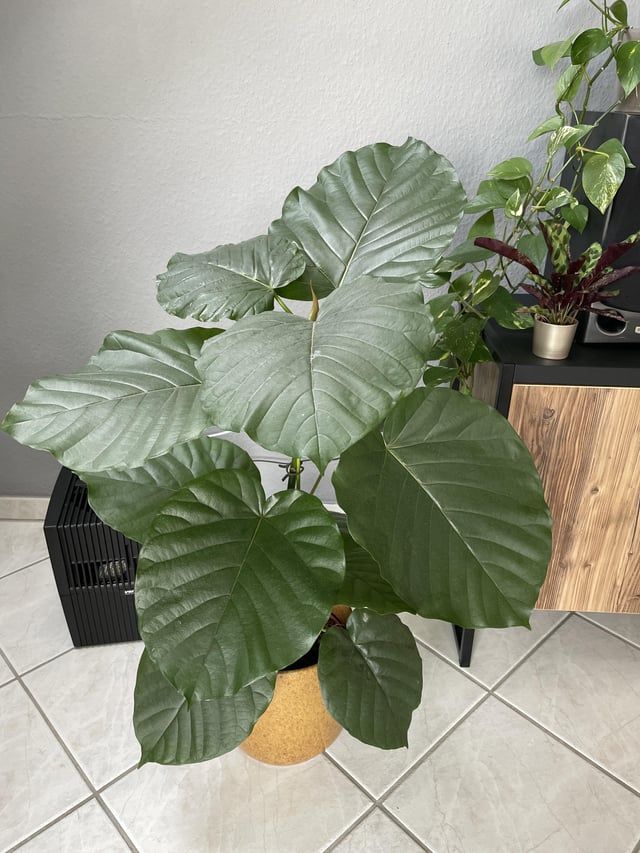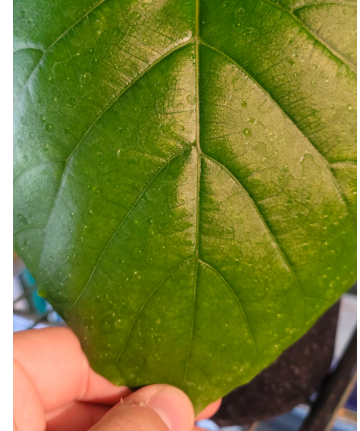Caring for Your Ficus Umbellata: From Lighting and Propagation to Pest Control
Ficus umbellata can tolerate low light conditions, but it prefers bright, indirect light. In low light, the plant may not grow as vigorously and the leaves may become smaller.

Are you the proud owner of a Ficus Umbellata?
This beautiful indoor plant, also known as "Umbrella Fig", is known for its elegant leaves and graceful growth habit. However, taking care of a Ficus Umbellata can be a bit tricky. From finding the right lighting conditions to controlling pests, it's important to know the ins and outs of caring for this plant.
In this guide, we'll cover everything you need to know to keep your Ficus Umbellata healthy and thriving. From propagation techniques, to dealing with common issues like spider mites and yellow leaves, we've got you covered.
So, whether you're a seasoned plant parent or just starting out, read on for all the tips and tricks you need to keep your Ficus Umbellata looking its best.
How much light does Ficus Umbellata need?
One of the key factors in keeping your Ficus Umbellata healthy and thriving is providing it with the right amount and type of light.
This elegant indoor plant prefers bright, indirect light but can tolerate a few hours of direct sunlight each day, before 10 am. However, too much direct sunlight can cause leaf burn and discoloration, so it's best to err on the side of caution.
Finding the Right Lighting for Your Ficus Umbellata
When it comes to providing the right amount of light, it's also important to consider the location of your plant. Place it next to a window that does not receive a lot of sunlight.
If your plant is not getting enough light, you may notice it becoming leggy and producing fewer leaves. On the other hand, if it's getting too much light, the leaves may become yellow or discolored.
To ensure your Ficus Umbellata is getting the right amount of light, it's a good idea to rotate your plant occasionally, as this will ensure that all sides of the plant are getting an equal amount of light. If you don't have access to natural light, you can also use grow lights.
Make sure to avoid direct Sunlight

Ficus Umbellata is known to have paper-thin leaves which are sensitive to direct sunlight. Direct sunlight can cause leaf burn or sunscald on the leaves, which can lead to discoloration, browning, or even death of the leaves.
So, it's best to place the plant in a location where it will receive bright, indirect light, such as a spot near a window that receives filtered light through curtains.
Temperature requirements
Ficus Umbellata prefers temperatures between 60 and 75 degrees Fahrenheit (16 and 24 degrees celsius) and should be protected from drafts and extreme temperature changes.
You should pay attention to the level of ventilation the plant receives. Poor ventilation can lead to an increase in pests and diseases, as well as mold growth, which can harm the Ficus Umbellata. Make sure you place the plant in a well-ventilated area, such as near a window or in a room with a ceiling fan.
Additionally, try to avoid placing the plant too close to air conditioning units or outdoor units, as the draft from the unit can damage the leaves and cause leaf drop. This can also cause the plant to dry out, as the AC unit can suck out the moisture from the air.
It's best to keep a moderate distance from the unit or to adjust the direction of the airflow to avoid hitting the plant directly. This plant is very sensitive to changes in environment, so try not to move it around too much.
Watering requirements
Try to water the plant regularly from May to September, during the growing season. Only water the plant when the surface of the soil begins to dry, and make sure to water it thoroughly so that the water runs out of the bottom of the pot. It's important to check the soil moisture daily during summer, as the plant transpires well and it's easy to dry.
Avoid watering the plant when the soil is still moist. During the winter months, when the plant goes dormant, water sparingly and allow the soil to dry out for a few days. The Ficus umbellata has large leaves that transpire well, meaning that it releases a lot of water vapor through its leaves. This can make it susceptible to drying out, especially in low humidity environments.
So pay attention to this plant.
Propagation and Repotting
Water propagation: Water propagation is a popular and relatively simple method of propagating the Ficus plant. The process involves taking cuttings of the plant and rooting them in water before planting them in soil. The best time to take cuttings is during the spring or summer, when the plant is actively growing.
To water propagate a Ficus Umbellata, follow these steps:
- Take a cutting of the plant. Choose a healthy stem that has at least one leaf node (the point on the stem where leaves grow). Use a sharp pair of scissors or a knife to make a clean cut just below a leaf node.
- Remove the leaves from the bottom half of the cutting, leaving only a few leaves near the top.
- Place the cutting in a jar or glass of water. Make sure that the leaf node is submerged in water but the leaves are above the water line.
- Place the jar in a bright, warm spot out of direct sunlight.
- Change the water every few days to prevent it from becoming cloudy or smelly. After a few weeks, you should see new roots growing from the leaf node. Once the roots are 1-2 inches long, they are ready to be transplanted into soil.
- Plant the cutting in a small pot filled with well-draining potting soil. Be sure to keep the soil moist but not waterlogged.
It's worth noting that rooting in water is not the only method of propagation for Ficus Umbellata, it's also possible to root it directly in soil or by using the air layering method, but rooting in water is a popular method among plant enthusiasts and hobbyists.
Repotting the Ficus Umbellata
When growing Ficus Umbellata, it is important to pay attention to the condition of the leaves, as they can indicate the need for repotting. Signs that may indicate the need for repotting include:
- Wrinkled and drooping leaves
- Lack of growth, even during the growing season from May to September
- Water not being absorbed immediately into the soil, despite watering regularly
- Roots visible through the bottom of the pot or topsoil
- Drooping and falling leaves
- Yellowing leaves despite being in a warm and sunny location
If you notice any of these signs, it may be necessary to repot the plant to revive it. Repotting can help to address issues such as root clogging or root rot, and provide the plant with the proper environment to thrive.
When repotting Ficus Umbellata, it is recommended to use a pot that is one size larger than the current pot and to use commercially available potting soil specifically formulated for foliage plants. Make sure you choose a pot with good ventilation, such as a clay pot, terracotta, or concrete, and to avoid materials such as plastic or ceramic that have poor ventilation.
Here are the steps for repotting Umbellata:
- Allow the pot to dry before watering.
- Add about 1/3 of the soil to the top.
- Take it out of the pot in which it was planted, and remove about one-third of the soil from the root while rubbing it.
- Cut off any black or rotten roots with scissors.
- Place the Umbellata in the center of the pot and cover it with soil.
- Hit the side of the pot or put a chopstick in it and turn it around to make it completely filled with soil.
- After adding soil to 2-3cm below the edge of the pot, water the pot until water runs out from the bottom of the pot.
Subsequent management method:
- Keep it in bright shade for 1-2 weeks after repotting.
- Water when the topsoil is dry, but do not fertilize until new shoots appear.
- Once the Umbellata has stabilized, move it to a location with indirect light.
Pests and Diseases
Spidermites
Ficus Umbellata, like many other indoor plants, can be prone to spider mites infestation. Spider mites are small, spider-like pests that feed on plant sap, which can cause yellowing, discoloration, and wilting of leaves. They are particularly active in warm and dry conditions, which is often found in indoor environments.

How to get rid of Spidermites on Ficus Umbellata?
Find a spray made of hydrogen peroxide, neem oil, and peppermint oil. make sure it's diluted and then spray this solution on the plant and wipe the leaves down with a rag after 30mins. In most cases, your plant will be fine within 3 weeks.
To prevent spider mites infestation, it is important to maintain a healthy and humid environment for your Ficus Umbellata. This can be done by regularly misting the leaves, placing a tray of water near the plant, or using a humidifier. Also, make sure to keep the plant in a well-ventilated area and avoid overcrowding plants.
Powdery Mildew on Ficus Umbellata

Ficus Umbellata can be prone to powdery mildew, a disease that causes white spots on the leaves. To prevent this, it's important to take action when the disease is in its early stages.
This can be done by removing affected leaves or by using a solution of water and baking soda. Mixing 500ml to 1000ml of water with 1g of baking soda can be effective.
However, it's important to test the solution first to ensure it doesn't harm the plant. If used in high concentrations, baking soda can cause the plant to become deformed or stiff. This method is best used as a natural remedy in the early stages of the disease and should be used with caution.
Yellow Leaves on Ficus Umbellata plant

- Temperature: The Umberata may struggle to survive in temperatures below 5 degrees Celsius, which can lead to leaf drop or yellowing of the leaves.
- Watering: Over watering or under watering can cause the leaves of the Umberata to turn yellow. Over watering can lead to root rot and under watering can cause the leaves to dry out.
- Light: Umberata prefers bright indirect light, if it's getting too much direct sunlight, the leaves may turn yellow.
- Fertilizer: Over fertilizing or using the wrong type of fertilizer can cause the leaves of the Umberata to turn yellow.
- Pests: Pests such as spider mites, mealybugs, or thrips can cause the leaves of the Umberata to turn yellow.
- Repotting: when the roots of the Umberata become too crowded in its pot, it may not be able to absorb the necessary nutrients and water, causing the leaves to turn yellow. Additionally, if the soil is too dry or waterlogged, the roots may become damaged, resulting in yellow leaves.
Final Thoughts
Just remember to keep it in a sunny spot, but out of direct sunlight and make sure to water it when the soil is dry. And if you notice any yellowing leaves or powdery mildew, don't fret! With the proper care and attention, your Ficus Umbellata will thrive and bring joy to your space all year round.
In the next post we'll cover pruning methods for this plant.
Happy planting!